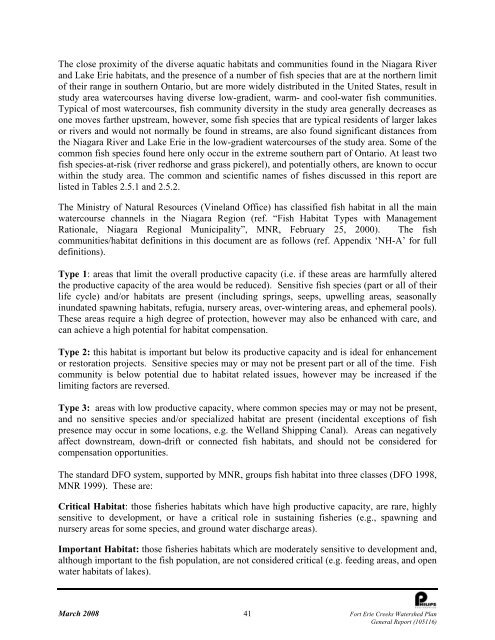Fort Erie Creeks Watershed Plan - Niagara Peninsula Conservation ...
Fort Erie Creeks Watershed Plan - Niagara Peninsula Conservation ...
Fort Erie Creeks Watershed Plan - Niagara Peninsula Conservation ...
Create successful ePaper yourself
Turn your PDF publications into a flip-book with our unique Google optimized e-Paper software.
The close proximity of the diverse aquatic habitats and communities found in the <strong>Niagara</strong> River<br />
and Lake <strong>Erie</strong> habitats, and the presence of a number of fish species that are at the northern limit<br />
of their range in southern Ontario, but are more widely distributed in the United States, result in<br />
study area watercourses having diverse low-gradient, warm- and cool-water fish communities.<br />
Typical of most watercourses, fish community diversity in the study area generally decreases as<br />
one moves farther upstream, however, some fish species that are typical residents of larger lakes<br />
or rivers and would not normally be found in streams, are also found significant distances from<br />
the <strong>Niagara</strong> River and Lake <strong>Erie</strong> in the low-gradient watercourses of the study area. Some of the<br />
common fish species found here only occur in the extreme southern part of Ontario. At least two<br />
fish species-at-risk (river redhorse and grass pickerel), and potentially others, are known to occur<br />
within the study area. The common and scientific names of fishes discussed in this report are<br />
listed in Tables 2.5.1 and 2.5.2.<br />
The Ministry of Natural Resources (Vineland Office) has classified fish habitat in all the main<br />
watercourse channels in the <strong>Niagara</strong> Region (ref. “Fish Habitat Types with Management<br />
Rationale, <strong>Niagara</strong> Regional Municipality”, MNR, February 25, 2000). The fish<br />
communities/habitat definitions in this document are as follows (ref. Appendix ‘NH-A’ for full<br />
definitions).<br />
Type 1: areas that limit the overall productive capacity (i.e. if these areas are harmfully altered<br />
the productive capacity of the area would be reduced). Sensitive fish species (part or all of their<br />
life cycle) and/or habitats are present (including springs, seeps, upwelling areas, seasonally<br />
inundated spawning habitats, refugia, nursery areas, over-wintering areas, and ephemeral pools).<br />
These areas require a high degree of protection, however may also be enhanced with care, and<br />
can achieve a high potential for habitat compensation.<br />
Type 2: this habitat is important but below its productive capacity and is ideal for enhancement<br />
or restoration projects. Sensitive species may or may not be present part or all of the time. Fish<br />
community is below potential due to habitat related issues, however may be increased if the<br />
limiting factors are reversed.<br />
Type 3: areas with low productive capacity, where common species may or may not be present,<br />
and no sensitive species and/or specialized habitat are present (incidental exceptions of fish<br />
presence may occur in some locations, e.g. the Welland Shipping Canal). Areas can negatively<br />
affect downstream, down-drift or connected fish habitats, and should not be considered for<br />
compensation opportunities.<br />
The standard DFO system, supported by MNR, groups fish habitat into three classes (DFO 1998,<br />
MNR 1999). These are:<br />
Critical Habitat: those fisheries habitats which have high productive capacity, are rare, highly<br />
sensitive to development, or have a critical role in sustaining fisheries (e.g., spawning and<br />
nursery areas for some species, and ground water discharge areas).<br />
Important Habitat: those fisheries habitats which are moderately sensitive to development and,<br />
although important to the fish population, are not considered critical (e.g. feeding areas, and open<br />
water habitats of lakes).<br />
March 2008 41 <strong>Fort</strong> <strong>Erie</strong> <strong>Creeks</strong> <strong>Watershed</strong> <strong>Plan</strong><br />
General Report (105116)
















